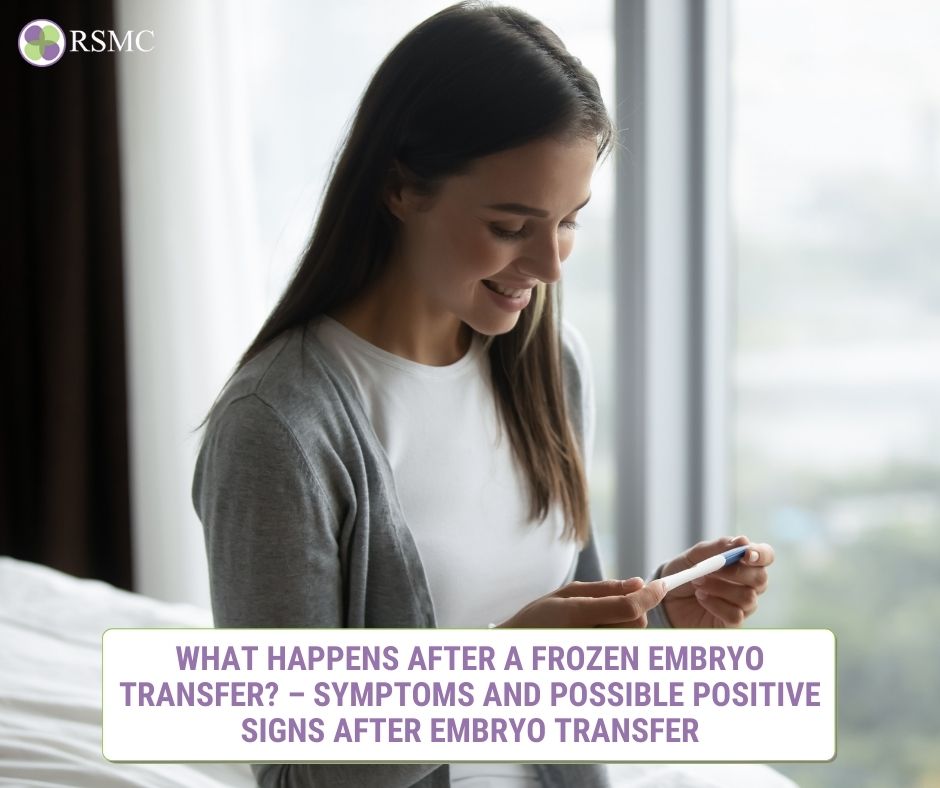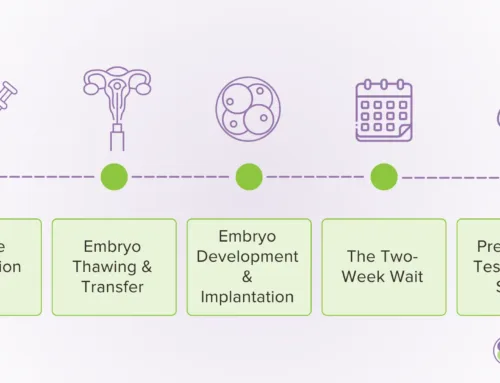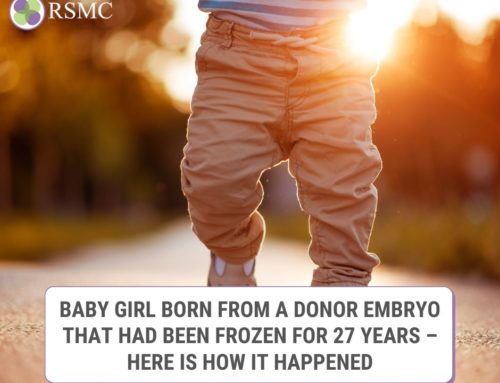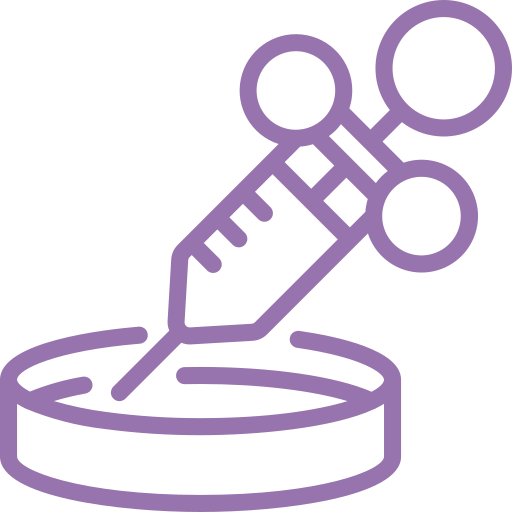A frozen embryo transfer is an excellent family-building option for couples or individuals struggling to have their own children. But while it’s a regular medical procedure, it is important to take care of yourself after the appointment to lower the risk of side effects, ensure your safety, and increase the chances of successful implantation and pregnancy. Many intended mothers often wonder what symptoms they are likely to experience in the next 7 days after their embryo transfer and whether there are any positive signs they can rely on to consider the implantation was successful.
The waiting period before a frozen embryo transfer can be a very difficult time for intended parents. After all, it is the final step of your investment towards adding a new family member to your family.
Maybe you want your body to rest following an egg retrieval procedure, or you originally wanted to undergo fertility preservation but now desire to conceive using a previous cycle’s frozen egg or frozen embryo.
No matter what your reason is, an embryo transfer can evoke a wide range of emotions, from the hope that you may become pregnant to anxiety and helplessness that nothing more can be done to improve your chances of success at this stage.
Although it is normal to experience these feelings, you can be assured that frozen embryos as just as good fresh ones when used for IVF. Some studies have even suggested that they have slightly better chances of success.
However, it is important to a full grasp of the frozen embryo transfer procedure and what to expect in the following days so that you can feel more relaxed and ready for the result of your IVF treatment.
In this article, we are going to cover all the various stages of the treatment, the symptoms you are likely to face after the procedure, and if they are positive signs of pregnancy or caused by the medications taken during the procedure. For better discussion, let’s break it into the following topics:
- What happens on the day of the frozen embryo transfer (FET)
- The frozen embryo transfer procedure
- Post-procedure guidelines
- Post-procedure symptoms after frozen embryo transfer
- Positive pregnancy signs after embryo transfer
- Healthy habits that promote successful implantation
- Why you shouldn’t conduct a home pregnancy test
- Receiving the results of your pregnancy test
What occurs on the day of the frozen embryo transfer?
A frozen embryo transfer (FET) is a simple medical procedure that requires no anesthesia. In this procedure, the fertility doctor thaws the frozen embryo and uses a tiny hollow tube (catheter) to place it past the cervix into the patient’s womb.
You will notice that the embryo is transferred into a specific place in the womb during this procedure, and that’s why it is usually carried out using ultrasound. Besides, the use of ultrasound helps promote comfort as it enables the doctor to know exactly where to place the catheter, lowering the risk of it touching your cervix.
Once the embryo transfer is done, you will be told to lie down on your back and relax for an hour. However, you may not need such a long resting time after embryo transfer since it’s a slightly invasive procedure. The whole process, including rest time, takes about 2-4 hours.
Your IVF clinic will then give you detailed instructions after the treatment to help you feel relax and to ensure you’re taking good care of yourself in the waiting period before your pregnancy test.
Some fertility doctors recommend a full day rest after the transfer, whereas others suggest making low-impact movement to improve the blood circulation to the uterus in order to increase the chance of becoming pregnant.
There is no scientific evidence that suggests an ideal post-procedure recommendation, so feel free to do whatever you deem best for you – be it a brisk walk or short napping to relieve stress. However, you need to stay away from high or even moderate levels of exercise after an embryo transfer.
Usually, patients take the rest of the day off to relax before going back to their regular activity the following day. Also, patients who want additional reassurance may be advised to continue taking progesterone to improve their chances of a healthy pregnancy.
What to expect in the following days after the transfer
While a frozen embryo transfer can be a promising new beginning for many people, you may feel anxious and unsure of what to do in the two-week waiting period before taking your pregnancy test. This test is conducted to find out whether the embryo transfer was successful and resulted in a pregnancy.
Do not take a pregnancy test soon after frozen embryo transfer
A two-week wait is recommended because pregnancy tests that are done too soon after the procedure often give false results. The reason for this is that the levels of the hormone detected in a pregnancy test, hCG, can vary depending on your current phase in your fertility journey, e.g., very early pregnancy does not usually produce much progesterone, which can make you get a false negative result.
Symptoms and Signs you may experience after frozen embryo transfer
Although some of the symptoms experienced after an embryo transfer and during the 14 days wait may be similar to pregnancy, they can also be caused by the fertility medications and other injectables you have been taking to prepare for FET.
Such symptoms are mostly due to the progesterone and estrogen given to you prior to the embryo transfer, and the progesterone hormones taken after the transfer. These hormones are known to cause breast soreness, bloating, and fluid discharge during pregnancy. This is why many women consider these as positive signs of pregnancy after an embryo transfer.
During the 14 days wait before your pregnancy test, you may experience menstruation-like symptoms, such as:
1. Bleeding or spotting
Bleeding or spotting is usually the first symptom of pregnancy after a frozen embryo transfer.
Seeing little blood on your underwear can be a mark of successful implantation, which means that the embryo has attached to the lining of the uterus. This is why, according to fertility experts, spotting or bleeding a few days after an embryo transfer can be a positive sign. However, it can feel very disturbing and does not usually give women the reassurance they desire.
Spotting is also a common symptom when you are taking progesterone during the two-week wait period post-embryo transfer.
Most probably, your physician will recommend that you continue taking progesterone hormone until the day of your pregnancy test to help your body produce the same levels of hormones it would during the early weeks of pregnancy. So, spotting is not always a positive sign of pregnancy after an embryo transfer.
2. Cramping
Cramping is one of the symptoms that indicate “menses” are on the way. But it can also be a sign of a successful embryo transfer.
Before you conduct a pregnancy test, keep in mind that mild cramping can also be a result of taking progesterone during the two-week wait period. Moreover, some women may develop cramping immediately after a pelvic procedure.
3. Sore breasts
Sore breasts are one of the first signs of pregnancy in women.
If you discover that your breasts are swollen or tender, it could be a positive indicator of a successful embryo transfer.
However, sore breasts can also be due to the hormone medication you are using during the two-week wait period. Both oral and injectable progesterone can make your breasts soft and tender.
4. Fatigue or tiredness
Fatigue is a completely normal symptom during the 7 days after embryo transfer and till the delivery day. You may even feel more sleepy early in the pregnancy when your levels of progesterone go up.
Generally, women experience fatigue when their period is around the corner. But while this can be a sign of a positive embryo transfer, it can also be due to the fertility medications you are taking.
One of the common causes of fatigue is elevated progesterone levels, which may be due to pregnancy or the fertility medications prescribed by the doctor.
5. Nausea
Nausea or morning sickness usually begins in the second month of pregnancy. So, it is not normally a sign you would see in the two-week wait period after an embryo transfer.
A lot of women who do experience nausea report that they feel very sick about two weeks after missing their period.
However, if you experience vomiting or nausea during the waiting period, take notice of this – especially if it happens frequently – and consult your doctor.
6. Bloating
Bloating can be caused by an increase in the levels of progesterone in the body. When this hormone surges as it normally does during pregnancy or when taking fertility medications, it can affect your GIT (gastrointestinal tract) and make you feel more bloated.
It can also occur before your menstruation, if you’re pregnant, or when taking hormone medications during IVF and after an embryo transfer.
7. Changes in vaginal discharge
If you are prescribed progesterone in the form of vagina gels, tablets, or suppositories during the two-week wait, you may observe changes in your vagina discharge, which have nothing to do with a successful pregnancy test.
Side effects of vagina tablets or suppositories include burning, discharge, itching, and yeast infections.
However, an increase in vaginal discharge in the early 7 days after an embryo transfer can be a positive sign of pregnancy. If the changes are due to a successful embryo transfer, you are going to notice a white, mild-smelling discharge during the early weeks of the pregnancy.
8. Increased urination
Frequent late-night trips to the bathroom can also be a sign of pregnancy.
While some women say they experience increased urination before missing their period, this symptom is usually noticed after a missed period.
It is often due to an increase in the levels of progesterone and the pregnancy hormone (hCG). If your embryo transfer was successful, the increased urination could be a result of extra blood in your body.
However, it can also be a sign of a urinary tract infection. So, you need to talk to your doctor if you also notice any of the symptoms below:
- Fever
- Bleeding
- Painful urination
- Nausea and vomiting
- Urgency to pee
9. Missed period
A missed menses can be a positive sign of pregnancy after embryo transfer, especially if your menstrual cycle goes like clockwork. For women who have regular periods every month, being late can signal that it is time to carry out a pregnancy test.
10. No symptoms
If you don’t notice any of the above symptoms, don’t worry. The fact you’re not experiencing certain symptoms even after 7 days of the procedure does not necessarily mean that your embryo transfer was unsuccessful.
The presence or absence of symptoms does not predict the possible outcome of a pregnancy test. Most of these symptoms are just a result of progesterone and estrogen use.
In fact, about 10-15% of patients who don’t show any signs after embryo transfer, later have a positive pregnancy test.
Only a pregnancy test can confirm whether or not your embryo transfer was a success.
Day by day embryo development stages after implantation:
While you are experiencing the above-mentioned symptoms after a frozen embryo transfer, your to-be-baby is also growing and developing in the womb. Here is what happens to the embryo during the 9 days after a transfer:
Day 1:
After the blastocyst(s) (day 5 embryo is called a “blastocyst” or “blast”) are transferred, the cells keep dividing. This is known as hatching. The cells will keep on dividing throughout this process.
Day 2:
The blastocyst continues hatching. The second day is also crucial as this is when the embryo starts to attach itself to the uterine lining.
Day 3:
The blastocyst attaches deeper into the uterine lining and the implantation begins. It’s normal to experience light bleeding and spotting on this day.
Day 4:
Implantation continues. The blast continues to dig deeper into the uterus and attaches to the endometrial blood vessel to nourish itself through the mother’s blood supply. However, the absence of bleeding, cramping, and/or spotting does not always mean implantation was unsuccessful.
Day 5:
Implantation is considered to have completed. Now, the cells that would eventually become the placenta and fetus have begun to develop.
Day 6:
The syncytiotrophoblast cells – the specialized cells that will form the placenta – start secreting hCG or human chorionic gonadotropin and begin to enter the bloodstream. HCG is the hormone that indicates a developing pregnancy and is picked up in pregnancy tests. It triggers increased progesterone production during the first trimester in order to enhance the womb lining to sustaining the growing embryo/fetus.
Days 7:
The embryo is now a fetus. It continues to grow and develop fast. The placenta begins to take shape and continues to release more hCG into the bloodstream.
Days 8:
The fetus continues to develop, the placenta begins to function and more hCG is released into the bloodstream.
Day 9:
By this time hCG levels in the mother’s blood are high enough to be detected through a blood test.
You may consider a home pregnancy test but if the test is negative, remember it could be a false negative. It’s best to wait for another 3 – 5 days and take the test again. The beta HCG blood test is more reliable and usually takes place about 10 – 14 days after blastocyst transfer.
What precautions can I take to raise the success chances of the Frozen Embryo Transfer?
Unfortunately, there is nothing more you can do to improve your chances of successful implantation once your embryo transfer is complete. This means that all you can do during the two-week wait before your pregnancy test is rest and hope for the best.
You just have to ensure you have enough sleep and avoid substances that can cause harm to the pregnancy, i.e., alcohol, tobacco, and caffeine.
In most cases, you will be told to abstain from sex and any strenuous activity, as womb contractions can cause the transfer to fail if the embryo is hindered while trying to implant in the uterus. Besides, this will increase your comfort and lower the risk of developing complications like ovarian distortion, which can occur since the ovaries are naturally bigger and tender after an embryo transfer procedure.
Moreover, you should eat a healthy diet containing large amounts of protein, vegetables, fruits, and “good” fat. Avoid foods that can pose risks to your pregnancy, such as raw seafood or unpasteurized dairy products, and ask your physician for a list of food to avoid during this period.
One more way to ensure you are healthy is to make sure you have emotional support and people you can turn to while waiting to conduct a pregnancy test. This support can come from your partner, friends, therapist, or even an online community of people passing through the same process.
Taking a pregnancy test after a frozen embryo transfer
The next thing is to conduct a pregnancy test after your frozen embryo transfer. To get a more accurate result, you will be scheduled for a clinic appointment two weeks after the procedure, where a blood test will be carried out to find out if you are pregnant or not.
If your pregnancy test comes back positive, congratulations! You are now confirmed pregnant, and your frozen embryo transfer worked. This means you will stay under the fertility clinic’s care for further monitoring of the pregnancy development through ultrasounds and blood tests until you are 8-10 weeks gone. This is when you can go to your obstetrician/gynecologist to continue on your journey to becoming a parent.
A lot of couples take comfort in the fact that, based on the cause of infertility, it is not uncommon for patients to have a failed embryo transfer the first time before finally getting the pregnancy they want in their second cycle of IVF.
Also, it is important to surround yourself with supportive friends and family who constantly remind you that you’re a fulfilled person whether your fertility treatment worked or not.
It’s normal to face challenges on your fertility journey, and a negative pregnancy outcome doesn’t mean that you should give up on trying to have a baby. Your doctor will give you a true assessment and success chances of further fertility treatments you can go for. And if you wish to consider other fertility options or undergo another IVF cycle, both of you can work together to determine what your next steps would be.
Although some doctors and patients like to wait for a while to give the body enough time to recover when beginning a new IVF cycle, others are okay with starting treatment as soon as they receive their pregnancy test results. However, this will depend on several factors like your health state, ovulation cycle, etc.
Getting ready for a frozen embryo transfer
Whether you are trying to preserve your fertility for the future or have a health condition that is affecting your egg supply, we can help. At RSMC, we offer frozen embryo transfers as well as other fertility treatments for hopeful parents.
Have questions about FET, IVF, or other fertility tests and treatments? Take a fertility consultation and get the answers from our fertility experts. Feel free to use the chat option for more queries.
Table of Contents
- What occurs on the day of the frozen embryo transfer?
- What to expect in the following days after the transfer
- Symptoms and Signs you may experience after frozen embryo transfer
- Day by day embryo development stages after implantation:
- What precautions can I take to raise the success chances of the Frozen Embryo Transfer?
- Taking a pregnancy test after a frozen embryo transfer
- Getting ready for a frozen embryo transfer























